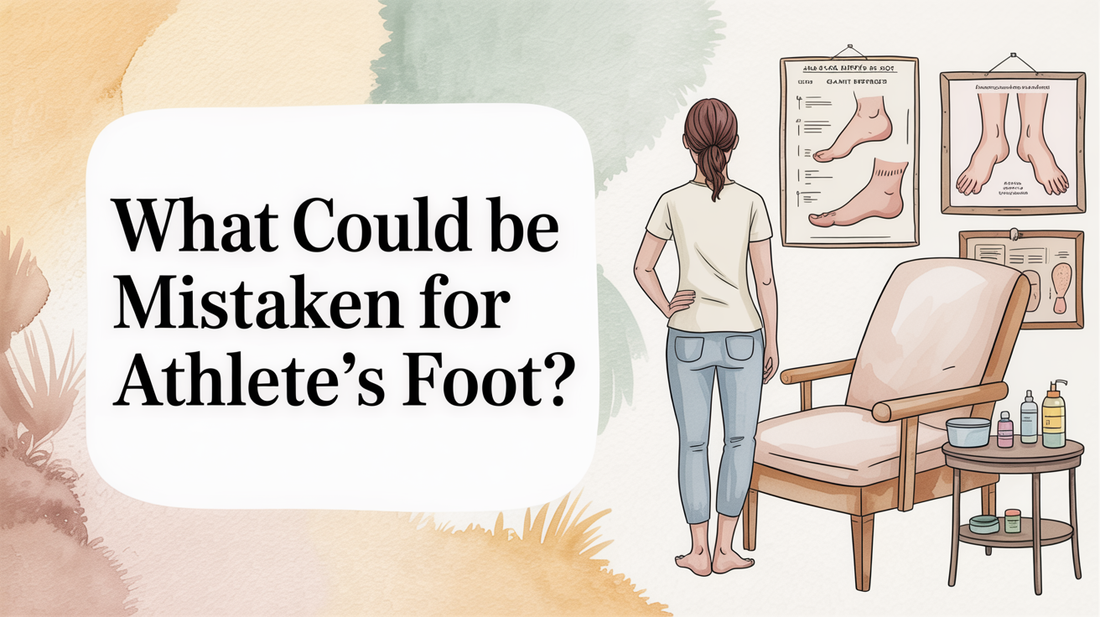What could be mistaken for athlete’s foot?
dyshidrotic eczema, plantar psoriasis, pitted keratolysis vs. tinea — If you’re experiencing discomfort on your feet, you might be wondering whether it’s athlete’s foot or another condition. Understanding the subtle differences can be key to finding effective relief. This post outlines three sections that clarify these common skin issues, so you can take action toward soothing your feet tonight.
Top 5 Mimics on the Feet 🧭
Many skin conditions can mimic athlete's foot, leading to confusion and misdiagnosis. These conditions often share symptoms such as itching, scaling, and changes in skin texture, but they arise from different causes and may require tailored treatments. Here are some common foot conditions that can resemble athlete's foot:
- Dyshidrotic eczema: This condition may lead to small, fluid-filled blisters on the soles of the feet, often triggered by stress or allergies.
- Plantar psoriasis: This causes thick, scaly patches on the soles, potentially affecting the nails too.
- Pitted keratolysis: A bacterial infection that produces small pits or holes, particularly in areas that bear weight.
- Contact dermatitis: An allergic reaction that may cause redness and blistering due to certain footwear or topical products.
- Trench foot: Caused by prolonged moisture exposure, leading to swelling and tissue breakdown.
Try It Tonight: Calm, Fresh Feet ✨
- Wash feet with warm water and a mild cleanser, making sure to dry thoroughly between the toes.
- Apply a small amount of Kissable Feet where needed; massage until absorbed.
- Allow your skin to breathe; consider wearing breathable socks if desired. Remember to patch-test if you're new to this foot cream.
Key Differences You Can See ✨
Visual assessments can often reveal distinguishing features between athlete's foot and its mimics, although a definitive diagnosis typically requires a professional evaluation. Here are some key differences to consider:
- Location patterns: Athlete's foot usually affects the spaces between toes and can spread outwards, while eczema often appears as patches, and psoriasis shows a more symmetrical involvement.
- Blister characteristics: Dyshidrotic eczema may produce deep, tapioca-like vesicles, whereas athlete's foot typically forms superficial blisters that may rupture easily.
- Scale appearance: Psoriasis presents thick, silvery scales with sharp borders, while athlete's foot has finer, powdery scaling.
- Odor presence: Pitted keratolysis tends to emit a foul odor, unlike other conditions that are generally odorless.
- Nail involvement: Psoriasis can affect the nails, causing pitting and discoloration, whereas athlete's foot may lead to nail thickening.
Why We Recommend a Gentle Helper 🌿
Kissable Feet is thoughtfully crafted for quick absorption and a soothing experience without the sting. This nurse-crafted blend, featuring tea tree oil, coconut, and calendula, provides comfort and a clean finish, making it easy to incorporate into your nightly routine.
- Fast-absorbing comfort—non-greasy finish.
- Gentle sensation ideal for sensitive, overworked feet.
- Clean, bedtime-friendly scent.
Doctor Tests That Settle It 🔍
Healthcare professionals utilize various diagnostic tests to accurately differentiate between athlete's foot and conditions that may appear similar. These tests can range from straightforward procedures performed in the office to specialized laboratory analyses.
- KOH (potassium hydroxide) test: A direct microscopic examination of skin scrapings to identify any fungal elements.
- Fungal culture: Growing skin samples on special media for a few weeks to determine specific fungal species and their antifungal sensitivity.
- Dermoscopy: A magnified skin examination that reveals characteristic patterns associated with certain conditions.
- Patch testing: Applying potential allergens to detect triggers of contact dermatitis when allergic reactions are suspected.
- Bacterial culture: Swabbing affected areas to identify possible bacterial pathogens in cases like pitted keratolysis.

